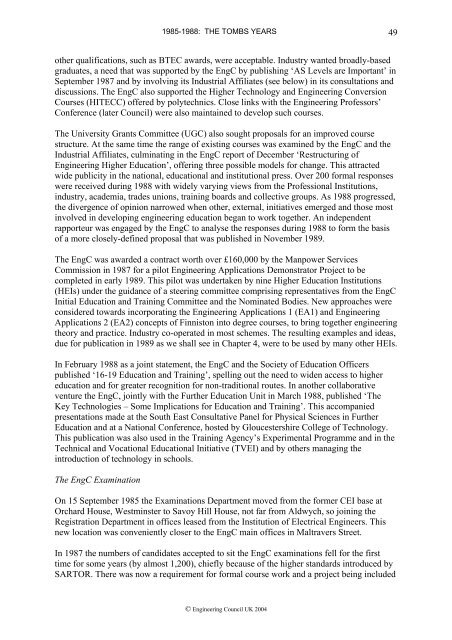An Engine for Change - A Chronicle of the Engineering Council
An Engine for Change - A Chronicle of the Engineering Council
An Engine for Change - A Chronicle of the Engineering Council
You also want an ePaper? Increase the reach of your titles
YUMPU automatically turns print PDFs into web optimized ePapers that Google loves.
1985-1988: THE TOMBS YEARS 49o<strong>the</strong>r qualifications, such as BTEC awards, were acceptable. Industry wanted broadly-basedgraduates, a need that was supported by <strong>the</strong> EngC by publishing ‘AS Levels are Important’ inSeptember 1987 and by involving its Industrial Affiliates (see below) in its consultations anddiscussions. The EngC also supported <strong>the</strong> Higher Technology and <strong>Engine</strong>ering ConversionCourses (HITECC) <strong>of</strong>fered by polytechnics. Close links with <strong>the</strong> <strong>Engine</strong>ering Pr<strong>of</strong>essors’Conference (later <strong>Council</strong>) were also maintained to develop such courses.The University Grants Committee (UGC) also sought proposals <strong>for</strong> an improved coursestructure. At <strong>the</strong> same time <strong>the</strong> range <strong>of</strong> existing courses was examined by <strong>the</strong> EngC and <strong>the</strong>Industrial Affiliates, culminating in <strong>the</strong> EngC report <strong>of</strong> December ‘Restructuring <strong>of</strong><strong>Engine</strong>ering Higher Education’, <strong>of</strong>fering three possible models <strong>for</strong> change. This attractedwide publicity in <strong>the</strong> national, educational and institutional press. Over 200 <strong>for</strong>mal responseswere received during 1988 with widely varying views from <strong>the</strong> Pr<strong>of</strong>essional Institutions,industry, academia, trades unions, training boards and collective groups. As 1988 progressed,<strong>the</strong> divergence <strong>of</strong> opinion narrowed when o<strong>the</strong>r, external, initiatives emerged and those mostinvolved in developing engineering education began to work toge<strong>the</strong>r. <strong>An</strong> independentrapporteur was engaged by <strong>the</strong> EngC to analyse <strong>the</strong> responses during 1988 to <strong>for</strong>m <strong>the</strong> basis<strong>of</strong> a more closely-defined proposal that was published in November 1989.The EngC was awarded a contract worth over £160,000 by <strong>the</strong> Manpower ServicesCommission in 1987 <strong>for</strong> a pilot <strong>Engine</strong>ering Applications Demonstrator Project to becompleted in early 1989. This pilot was undertaken by nine Higher Education Institutions(HEIs) under <strong>the</strong> guidance <strong>of</strong> a steering committee comprising representatives from <strong>the</strong> EngCInitial Education and Training Committee and <strong>the</strong> Nominated Bodies. New approaches wereconsidered towards incorporating <strong>the</strong> <strong>Engine</strong>ering Applications 1 (EA1) and <strong>Engine</strong>eringApplications 2 (EA2) concepts <strong>of</strong> Finniston into degree courses, to bring toge<strong>the</strong>r engineering<strong>the</strong>ory and practice. Industry co-operated in most schemes. The resulting examples and ideas,due <strong>for</strong> publication in 1989 as we shall see in Chapter 4, were to be used by many o<strong>the</strong>r HEIs.In February 1988 as a joint statement, <strong>the</strong> EngC and <strong>the</strong> Society <strong>of</strong> Education Officerspublished ‘16-19 Education and Training’, spelling out <strong>the</strong> need to widen access to highereducation and <strong>for</strong> greater recognition <strong>for</strong> non-traditional routes. In ano<strong>the</strong>r collaborativeventure <strong>the</strong> EngC, jointly with <strong>the</strong> Fur<strong>the</strong>r Education Unit in March 1988, published ‘TheKey Technologies – Some Implications <strong>for</strong> Education and Training’. This accompaniedpresentations made at <strong>the</strong> South East Consultative Panel <strong>for</strong> Physical Sciences in Fur<strong>the</strong>rEducation and at a National Conference, hosted by Gloucestershire College <strong>of</strong> Technology.This publication was also used in <strong>the</strong> Training Agency’s Experimental Programme and in <strong>the</strong>Technical and Vocational Educational Initiative (TVEI) and by o<strong>the</strong>rs managing <strong>the</strong>introduction <strong>of</strong> technology in schools.The EngC ExaminationOn 15 September 1985 <strong>the</strong> Examinations Department moved from <strong>the</strong> <strong>for</strong>mer CEI base atOrchard House, Westminster to Savoy Hill House, not far from Aldwych, so joining <strong>the</strong>Registration Department in <strong>of</strong>fices leased from <strong>the</strong> Institution <strong>of</strong> Electrical <strong>Engine</strong>ers. Thisnew location was conveniently closer to <strong>the</strong> EngC main <strong>of</strong>fices in Maltravers Street.In 1987 <strong>the</strong> numbers <strong>of</strong> candidates accepted to sit <strong>the</strong> EngC examinations fell <strong>for</strong> <strong>the</strong> firsttime <strong>for</strong> some years (by almost 1,200), chiefly because <strong>of</strong> <strong>the</strong> higher standards introduced bySARTOR. There was now a requirement <strong>for</strong> <strong>for</strong>mal course work and a project being included© <strong>Engine</strong>ering <strong>Council</strong> UK 2004
















